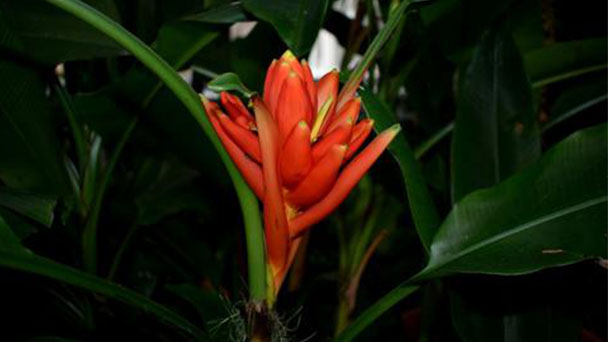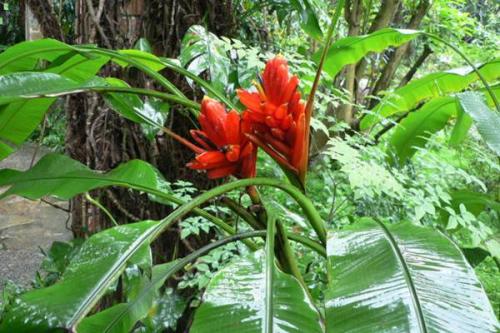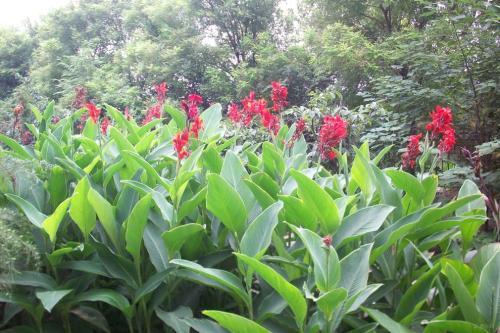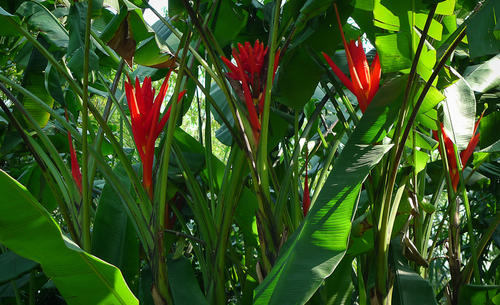Scarlet banana profile
Written by Maggie
Jan 08 2021

Scarlet banana, scientific name Musa coccinea, is a red banana plant in the Musa family, mainly distributed in some places in southern China, such as Fujian and Guangdong. It is shaped like a banana, but longer than a banana. Its flowers are bright red outside, pink inside, very delicate. It blooms between May and October.
Scarlet banana picture

Morphological characteristics of Scarlet banana
Scarlet banana ( Musa coccinea) is a herb of perennial roots. scarlet banana is 1 ~ 3 meters high, looks like a banana, only slightly thin; The pseudostem is erect; Leaves are long elliptic, with long stalk, like banana leaves, leaves 90 ~ 120 cm long, 20 ~ 40 cm wide; The fluorescence is four seasons, the inflorescence is terminal, the size of the inflorescence is 20 ~ 25 cm ×5 ~ 10 cm, the scapes are 1 ~ 1.2 m long, the spikes are arranged, the bracts are 10 ~ 25, closely arranged, the bracts are bright red and gorgeous outside, pink inside, the tip of the bracts is yellow, each bud bears 3 ~ 4 yellow flowers, also in spikes. After the flower the green berry, there are many fruit seeds, but can not be eaten. Each plant only opens 1 inflorescence, flowers fade after the plant gradually aging and death, but can be in the base of the growth of succulent buds. The formation of seedlings and then growth into new plants, so self-proliferation is fascicular.
The growth habits of Scarlet Banana
When growing Scarlet Banana, we need to pay attention to water and fertilizer. It is more fertilizer, but the requirements of fertilizer are not high. In the growing season, it can be fertilized every half a month or so. In its flower bud growth differentiation period, we can apply a few phosphate fertilizer, potash fertilizer, and promote the differentiation of flower buds. After the flowers fade, topdressing can be carried out to supplement the lost nutrients of the plant and restore its growth as soon as possible. In the winter when applying a little phosphate and potash fertilizer, it can make it better overwintering.
Scarlet banana cultivation management
Humidity management: Scarlet banana ( Musa coccinea) prefers a slightly humid climate environment, requiring the relative temperature of air in the growth environment of 50 ~ 70%.
Temperature management: Scarlet bananas ( Musa coccinea) like high temperature climate; The winter temperature requirements are very strict. When the ambient temperature is below 8℃, it stop growing, and the frost can not be safe overwintering.
When the ambient temperature is below 3℃, the correct treatment method is:
Wrap it in a film for the winter, but every two days in the noon when the temperature is higher to uncover the film to let it breathe;

Move it into a heated room for the winter.
Light management: in the high temperature season of summer (daytime temperature above 35℃), if it is placed in direct sunlight for maintenance, it will grow very slowly or enter a semi-dormant state, and the leaves will curl, even turn yellow, fall off. Therefore, in the hot summer, it is best to give it about 30 percent of the sun.
In spring, autumn and winter, because the temperature is not very high, it is necessary to give it direct sunlight, in order to facilitate its photosynthesis and the formation of flower buds, flowering, fruiting. Put in indoor maintenance, put it in the places with bright light, such as the living room with good daylighting, bedroom, study and other places. After a period of indoor maintenance (two months or so), it is necessary to move it to the outdoor shade (winter heat preservation conditions) of the place for maintenance for a period of time (a month or so).
Transferring the pot: Usually, it is not specially transferred, but it is replanted when it is combined with planting every year.
The effect of scarlet banana
Scarlet Banana ( Musa coccinea) is very ornamental. It blooms in the summer and fall, and when it blooms, the flowers are very showy, so it can be cultivated in the courtyard as a green flower. Its flowers can be taken off and used for flower arrangements.
But the fruit, flowers and roots of the scarlet banana are toxic and inedible.

Latest Updated
- Benefits of Bugleweed - 7 Science-backed Health Benefits
- Bugleweed Dangers & Side Effects - Is It Poisonous?
- How to Plant Evergreen Trees - What You Should Know
- When to Plant Evergreens - Grow Guide for Evergreen Trees
- 12 Wonderful Evergreen Shrubs for Your Garden
- 12 Popular Evergreen Plants with Pictures for Beginners
- When And How To Prune A Lilac Bush Like a Pro
- How to Grow & Care for Lilac Vine (Hardenbergia Violacea)
- Japanese Lilac Tree (Syringa Reticulata) Care & Propagation Guide
- Shumard Oak Pros and Cons - What to Know
Popular Articles
- Winter maintenance of Antirrhinum Majus
- How to Grow Terminalia Mantaly Tree
- How to Grow and Care for Crossostephium Chinense
- How to grow Antirrhinum Majus in spring
- Peristeria Elata (Dove Orchid) Profile: Info & Care Guide
- Underwatered Snake Plant (Sansevieria Trifasciata) - Signs And How To Fix
- How to Care for Brazilian Jasmine Plant (Mandevilla Sanderi)
- How to Grow & Care for Graptopetalum Purple Delight in Summer
- Rosa Chinensis (China Rose): Plant Growing & Care Tips
- How to Care for Baby Sun Rose (Aptenia Cordifolia)